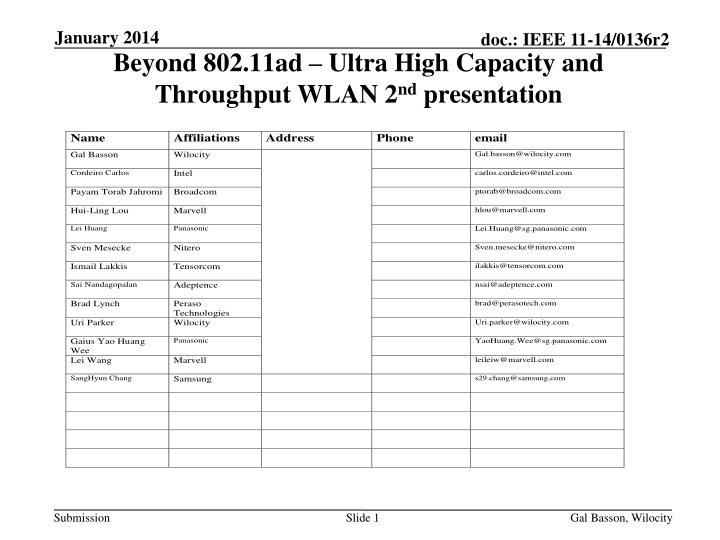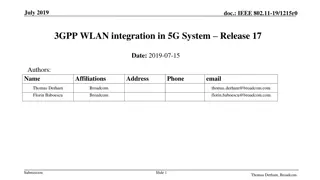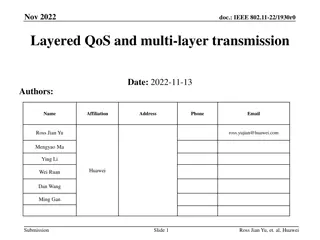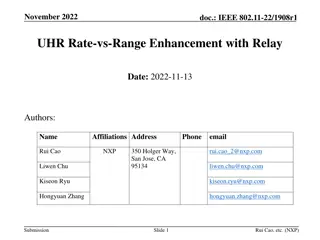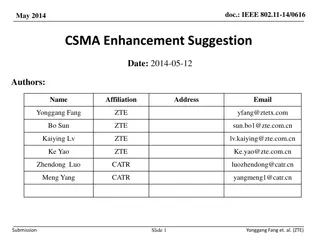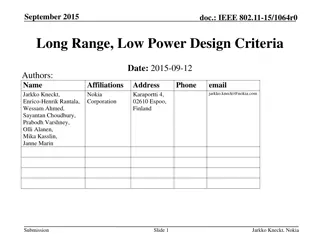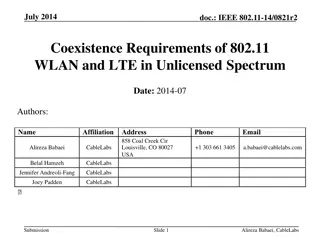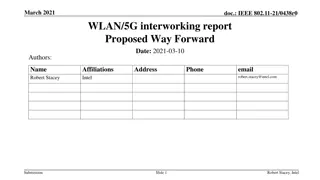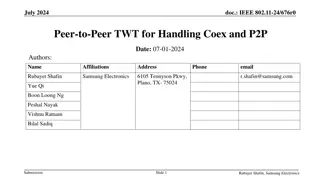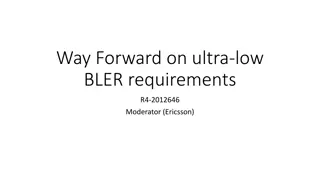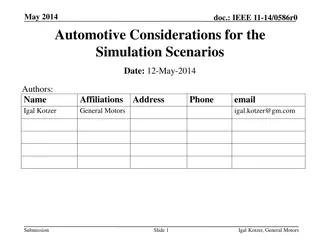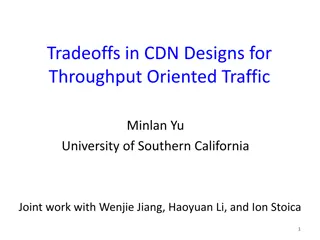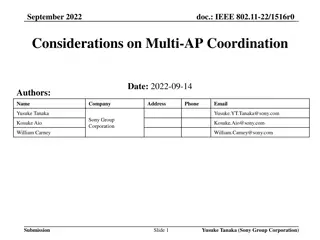Beyond 802.11ad: Ultra High Capacity and Throughput WLAN
The document from January 2014 discusses the exploration of modifications to IEEE 802.11ad-2012 PHY and MAC layers to enable modes of operation in the 60 GHz band capable of achieving a maximum throughput of at least 30 Gbps while maintaining the band's excellent capacity attributes. Topics include small antenna footprints, antenna arrays at 60 GHz, low operating SNR, and methods for enhancing throughput in next-generation 802.11ad networks.
Download Presentation

Please find below an Image/Link to download the presentation.
The content on the website is provided AS IS for your information and personal use only. It may not be sold, licensed, or shared on other websites without obtaining consent from the author.If you encounter any issues during the download, it is possible that the publisher has removed the file from their server.
You are allowed to download the files provided on this website for personal or commercial use, subject to the condition that they are used lawfully. All files are the property of their respective owners.
The content on the website is provided AS IS for your information and personal use only. It may not be sold, licensed, or shared on other websites without obtaining consent from the author.
E N D
Presentation Transcript
January 2014 doc.: IEEE 11-14/0136r2 Beyond 802.11ad Ultra High Capacity and Throughput WLAN 2nd presentation Name Affiliations Address Phone email Gal.basson@wilocity.com Gal Basson Wilocity Cordeiro Carlos Intel carlos.cordeiro@intel.com Payam Torab Jahromi Broadcom ptorab@broadcom.com Hui-Ling Lou Marvell hlou@marvell.com Lei.Huang@sg.panasonic.com Lei Huang Panasonic Sven Mesecke Nitero Sven.mesecke@nitero.com ilakkis@tensorcom.com Ismail Lakkis Tensorcom Sai Nandagopalan Adeptence nsai@adeptence.com Brad Lynch Peraso Technologies Wilocity brad@perasotech.com Uri Parker Uri.parker@wilocity.com Panasonic YaoHuang.Wee@sg.panasonic.com Gaius Yao Huang Wee Lei Wang Marvell leileiw@marvell.com Samsung SangHyun Chang s29.chang@samsung.com Submission Slide 1 Gal Basson, Wilocity
January 2014 doc.: IEEE 11-14/0136r2 Abstract We would like to continue the discussion about creating a new Study Group to explore modifications to the IEEE 802.11ad-2012 PHY and MAC layers, so that modes of operation in the 60 GHz band (57-66 GHz) can be enabled that are capable of a maximum throughput of at least 30 Gbps as measured at the MAC data service access point (SAP), while maintaining the excellent capacity attribute of the 60GHz band. Submission Slide 2 Gal Basson, Wilocity
January 2014 doc.: IEEE 11-14/0136r2 Agenda 802.11ad attributes Small antenna footprint Antenna arrays at 60GHz Low operating SNR Capacity at 60GHz Next generation (NG) 802.11ad High data rates usages reminder Methods for increasing the TPT Further innovation for next generation 802.11ad Submission Slide 3 Gal Basson, Wilocity
January 2014 doc.: IEEE 11-14/0136r2 802.11ad attributes (1) 60GHz has very small antenna footprint mm compared to cm Due to the low footprint, 60GHz communication can use antenna arrays Many advantages of using antenna array in 60GHz Increases link margin Increases directivity Implementation wise: higher efficiency when trying to get high EIRP numbers Submission Slide 4 Gal Basson, Wilocity
January 2014 doc.: IEEE 11-14/0136r2 802.11ad attributes (2) 802.11ad high rate is a result of using high BW (1.76 GHz) The operating SNR for 4.6Gbps is lower than 14 dB MCS 0 1 2 3 4 5 6 7 8 9 10 11 12 Rate[Mbps] CP 385 770 962.5 1155 1251 1540 1920 2310 2502 3080 3850 4620 Noise floor -82 -82 -82 -82 -82 -82 -82 -82 -82 -82 -82 -82 -82 Antenna Gain 5 5 5 5 5 5 5 5 5 5 5 5 5 NF 6.5 6.5 6.5 6.5 6.5 6.5 6.5 6.5 6.5 6.5 6.5 6.5 6.5 Array Gain 0 12 12 12 12 12 12 12 12 12 12 12 12 SNR -12 -0.35 0.71 2 3.3 4 3.64 4.9 6.35 7 11.1 12 13.3 Sensetivity -92.5 -92.85 -91.79 -90.5 -89.2 -88.5 -88.86 -87.6 -86.15 -85.5 -81.4 -80.5 -79.2 Submission Slide 5 Gal Basson, Wilocity
March 2013 doc.: IEEE 11-14/0136r2 802.11ad attributes: capacity (3) Directivity and low operating SNR are fantastic attributes to increase capacity 60GHz can significantly increase network capacity Directivity in many situations dramatically reduces or eliminates OBSS interference Low operating SNR means better resilience to interference We have shown amazing numbers of spatial reuse Simulation from 11-13 408r2 48 pairs Hall size 20x20x2.5 meters Submission Slide 6 Gal Basson, Wilocity
January 2014 doc.: IEEE 11-14/0136r2 Next Generation 802.11ad Submission Slide 7 Gal Basson, Wilocity
January 2014 doc.: IEEE 11-14/0136r2 Submission Slide 8 Gal Basson, Wilocity
January 2014 doc.: IEEE 11-14/0136r2 Methods for increasing the TPT Channel bonding [1] We have suggested 2 additional BW Double channel-5.28GHz Quadruple channel-10.56GHz We have shown technology feasibility of such an analog FE today. Marinating low power MIMO [1] Traditional MIMO Spatial orthogonal MIMO For receiver simplification Shown channel measurement 11-13 408r2 Sector #1 Sector #3 Sector #4 Sector #1 Sector #3 Sector #4 Sector #2 Sector #2 RX TX Sector #N Sector #N RED best ray and best pair of TX-RX sectors Green second best pair of sectors Blue third best pair of sectors Submission Slide 9 Gal Basson, Wilocity
January 2014 doc.: IEEE 11-14/0136r2 Example: rate table Data Rate (Gbps) BW=3.52GHz Modulation NSS PHY Code Rate BW=1.76GHz BW=7.04GHz /2-BPSK 1 SC 1/2 0.77 1.54 3.1 4.6 6.2 9.2 /2-BPSK /2-QPSK /2-QPSK 1 1 1 SC SC SC 3/4 1/2 3/4 1.155 1.54 2.31 2.31 3.08 4.62 /2-16QAM /2-16QAM 64QAM 1 1 1 SC SC 1/2 3/4 3/4 3.08 4.62 6.2 6.16 9.24 12.4 12.3 18.5 24.8 OFDM /2-BPSK /2-BPSK /2-QPSK /2-QPSK 2 2 2 2 SC SC SC SC 1/2 3/4 1/2 3/4 1.54 2.31 3.08 4.62 3.08 4.62 6.16 9.24 6.2 9.2 12.3 18.5 /2-16QAM /2-16QAM 64QAM 2 2 2 SC SC 1/2 3/4 3/4 6.16 9.24 12.4 12.32 18.48 24.8 24.6 37 49.6 OFDM /2-BPSK /2-BPSK /2-QPSK /2-QPSK 4 4 4 4 SC SC SC SC 1/2 3/4 1/2 3/4 3.08 4.62 6.16 9.24 6.16 9.24 12.32 18.48 12.3 18.5 24.6 37 /2-16QAM /2-16QAM 64QAM 4 4 4 SC SC 1/2 3/4 3/4 12.32 18.48 24.8 24.64 36.96 49.6 49.3 73.9 99.2 OFDM Submission Slide 10 Gal Basson, Wilocity
January 2014 doc.: IEEE 11-14/0136r2 Protocol overheads at high rates 802.11ad NG can introduce rates as high as 100Gbps 802.11ad introduced VERY low PHY overheads and low latency protocol 3 uSec SIFS PHY preambles including header <2usec Questions: Will these parameters affect such high data rates? What can be done in 802.11ad NG to accommodate this? Submission Slide 11 Gal Basson, Wilocity
January 2014 doc.: IEEE 11-14/0136r2 Protocol overheads at high rates The architecture assumes transmissions will have to be stored on chip due to transmission retry. On chip memory will grow bigger 5 years from now PHY Overhead high speed 100 Memory size 100KB Memory size 200KB Memory size 400KB Memory size 1MB Memory size 2MB Memory size 4MB Memory size 10MB 90 80 PHY OverHead 70 60 50 40 0 10 20 30 40 50 60 70 80 90 100 Speed [Gbps] Submission Slide 12 Gal Basson, Wilocity
January 2014 doc.: IEEE 11-14/0136r2 Possible additions to 802.11ad NG: ToF (1) TOF-Time of Flight Applications Proximity based (like security) Location based (together with DOA/DOD) 802.11ad already employs high sampling rate This enables high timing accuracy (10s of psec) 802.11ad NG will employ higher sampling rate, hence better timing accuracy Mechanisms can be added to improve TOF measurement Submission Slide 13 Gal Basson, Wilocity
January 2014 doc.: IEEE 11-14/0136r2 Possible additions to 802.11ad NG: ToF (2) 802.11v uses 10nsec timing resolution About 3 meters 802.11ad NG can reduce the resolution to 10s of cm s To increase accuracy, some of the ideas that can be considered include: Round Trip Time (RTT) with timestamp Assuming no clock sync Define a new Tx Rx transaction Clock drift to limit transaction time (<20us) Timestamp exchange capability at PHY/MAC level PHY support for TOF Signaling through the PHY header Submission Slide 14 Gal Basson, Wilocity
January 2014 doc.: IEEE 11-14/0136r2 Possible additions to 802.11ad NG: backhaul support There is a lot of industry interest in backhaul communication using 60 GHz ISM band Small antenna footprint Phased array Commodity Si is available (Price is lower) Usages are targeting up to 1Km range Need to explore the requirements and accommodate through 802.11ad NG Submission Slide 15 Gal Basson, Wilocity
January 2014 doc.: IEEE 11-14/0136r2 Summary 802.11ad-based products are shipping in the market today; more are expected to come in the near future Increasing demand for capacity and new applications are driving the desire to enhance 11ad to support these needs Technical feasibility to enhance 11ad with MIMO and channel bonding have been widely demonstrated Suggest that 802.11 start a new SG on next generation 11ad Submission Slide 16 Gal Basson, Wilocity
January 2014 doc.: IEEE 11-14/0136r2 Straw polls 1. Would you agree to form a new 802.11 SG on this topic at the May/14 802.11 meeting? Submission Slide 17 Gal Basson, Wilocity
January 2014 doc.: IEEE 11-14/0136r2 References 1. https://mentor.ieee.org/802.11/dcn/13/11-13-1408-01- 0wng-beyond-802-11ad-ultra-high-capacity-and-tpt- wlan.pptx Submission Slide 18 Carlos Cordeiro, Intel
January 2014 doc.: IEEE 11-14/0136r2 Backup Submission Slide 19 Gal Basson, Wilocity
November 2013 doc.: IEEE 11-14/0136r2 MIMO at 60 GHz: can we simplify? Reminder: 4.6 Gbps can be achieved at 13 dB SNR Can we create spatial orthogonal streams A diagonal channel matrix on the receiver 60 GHz require 10 dB SNR for decoding 3Gbps Training should be done via BF mechanism Sector sweep and BRP Low cost/complexity receiver lower digital complexity Sector #1 Sector #3 Sector #4 Sector #1 Sector #3 Sector #4 Sector #2 Sector #2 RX TX Sector #N Sector #N RED best ray and best pair of TX-RX sectors Green second best pair of sectors Blue third best pair of sectors Signal #2 Signal #1 Antenna elements Antenna array #2 Antenna array #1 Phase shifters RF signal Summators (RX) or Multiplexors (TX) RF To BB RF To BB Radio frequency to Baseband transformation Channel estimation and weights calculation Interference cancellation block Submission Slide 20 Gal Basson, Wilocity
November 2013 doc.: IEEE 11-14/0136r2 MIMO Channel measurement at 60GHz 1 0.9 0.8 0.7 0.6 LOS-planar array 0.5 0.4 0.3 0.2 0.1 0 0 20 40 60 80 100 120 140 Planar array-16 elements Channel matrix was measured (16x16) LOS and NLOS ???(??,? ??,? ) ?=1 ??= Antenna channel correlation- ??,? ?????,? ??,? ???(??,? ??,?) ?=1 ?=1 LOS-conductive 0.996-meaning all antennas see same channel LOS-0.724- not fully correlated Channel model D (IEEE 11n)- 0.4-0.5 Submission Slide 21 Gal Basson, Wilocity
